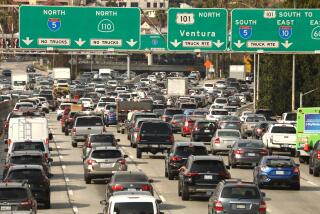Safety and the Open Road’s Call
- Share via
By leaving motorcycle helmet laws up to the states and repealing the 55-mph national speed limit, President Clinton and Congress have given drivers--particularly those on the open roads of the American West--license to hit the accelerator. But at what price? Though there is a romantic argument to be made for the freedom of the highways, one result surely will be an increase in both speed and traffic accidents.
Established in the mid-1970s, the 55-mph limit was designed to conserve fuel in the face of an Arab oil embargo. In time, however, the speed limit--together with auto safety improvements and tougher drunk driving laws--proved to be a major factor in reducing traffic fatalities, which dropped from 45,196 in 1973 to 40,676 in 1994. Now, with the federal limit lifted, California’s maximum posted speed limit will rise to 70 mph, with 65 the top speed on most roads.
Similarly, motorcycle helmet laws in California and other states, spurred by federal threats to withhold highway funding in their absence, have decreased mortality among riders by more than 900 a year nationwide since 1975. Since 1991, when California passed its helmet law, between 92 and 120 fewer cyclists have died each year, a considerable safety achievement. In addition, reductions in serious head injuries ultimately result in a saving to taxpayers, studies show.
Now there are rumblings that the Legislature may take another run at eliminating California’s helmet law as an intrusion on individual freedom. But the backers of such a change are forgetting something. When Congress moved to give states more responsibility by delegating authority on helmet laws, this did not mean it was all right for states to leave safety in the rear-view mirror.
More to Read
Sign up for Essential California
The most important California stories and recommendations in your inbox every morning.
You may occasionally receive promotional content from the Los Angeles Times.










